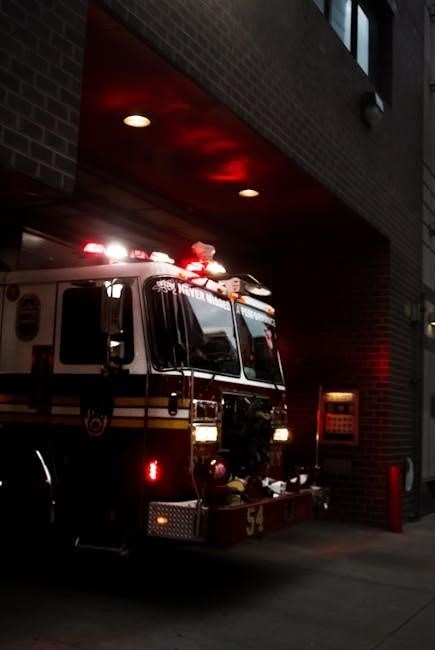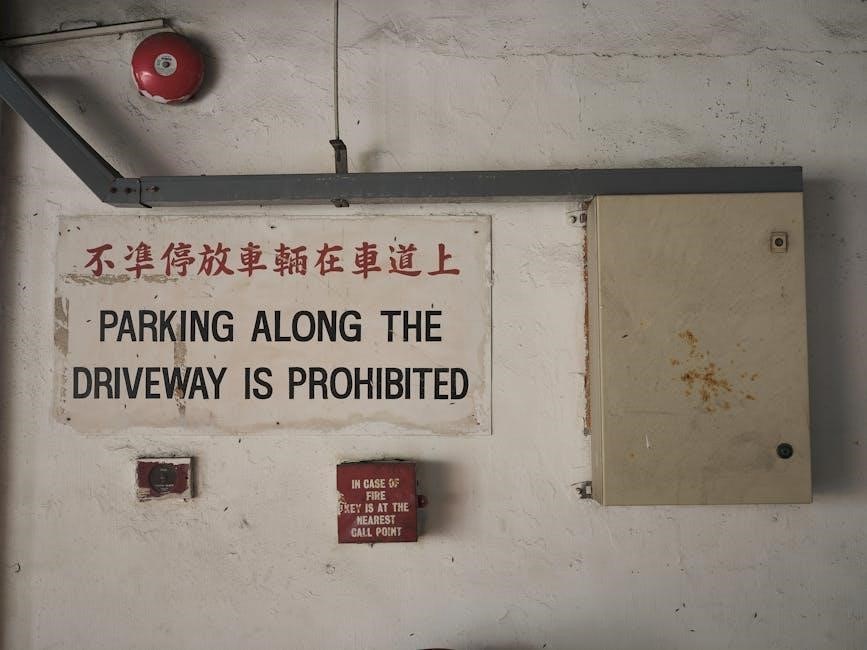First Alert carbon monoxide alarms are designed to protect your home and family from the dangers of CO poisoning. This guide provides essential instructions for installation, operation, and maintenance to ensure your safety and compliance with regulations. Understanding your alarm’s features and functions is crucial for effective protection against carbon monoxide threats.
Importance of Carbon Monoxide Alarms
Carbon monoxide alarms are vital for detecting deadly CO gas, which is odorless, colorless, and tasteless. They provide early warnings to prevent poisoning, ensuring safety in homes. CO alarms are legally required in many regions and are essential for protecting families. They offer peace of mind and can save lives by alerting occupants to dangerous CO levels before symptoms arise. Proper installation and maintenance are crucial for reliable protection.
Overview of First Alert CO Alarms
First Alert offers a range of carbon monoxide alarms with advanced features like digital displays and silence buttons. Models include battery-operated and plug-in options with battery backup. These alarms detect CO levels, providing clear warnings through beep patterns. They are designed for durability and reliability, with some featuring 10-year sealed batteries. First Alert CO alarms are user-friendly and comply with safety standards, ensuring effective protection against carbon monoxide threats in homes.
Key Components of First Alert Carbon Monoxide Alarms
First Alert CO alarms feature advanced sensors, digital displays, and silence buttons; They include battery-operated and plug-in models, ensuring reliable detection and user-friendly operation for home safety.
Parts and Features of the Alarm
The First Alert CO alarm includes essential components like a CO sensor, digital display, and silence button. Key features are a sealed battery, peak level button, and LED indicators. The alarm also has a test/silence button to check functionality or mute unnecessary alerts. Some models include a plug-in design with battery backup, ensuring continuous operation during power outages. These features work together to provide accurate detection and user-friendly operation, enhancing home safety and peace of mind.
Digital Display and Silence Feature
The digital display on First Alert CO alarms shows real-time CO levels, helping you assess potential dangers. The silence feature allows you to mute unnecessary alarms, such as those caused by cooking fumes, with the press of a button. This feature prevents false alarms without disabling the device, ensuring continued protection while reducing unwanted disturbances. The display also indicates when CO levels are below 30 ppm, providing essential information for your safety and peace of mind. This combination of functionality and convenience enhances user experience and ensures reliable monitoring of CO levels in your home. Additionally, the display’s clarity and the silence feature’s ease of use make it a practical solution for maintaining a safe environment. The alarm’s design prioritizes both accuracy and user comfort, making it an indispensable tool for home safety. By integrating these features, First Alert ensures that you stay informed and protected at all times, with minimal interruptions to your daily life. Furthermore, the digital display and silence feature work seamlessly together to provide a comprehensive safety solution tailored to your needs. This ensures that you can trust the alarm to alert you only when necessary, while still maintaining constant vigilance against carbon monoxide threats.
Installation Instructions
Install your First Alert CO alarm in central locations and on every level of your home. Place alarms away from vents and direct sunlight for optimal performance. Follow the user manual for specific placement guidelines and ensure the device is securely mounted. Test the alarm after installation to confirm proper functionality and sensitivity.
Choosing the Right Location for the Alarm
Place your First Alert carbon monoxide alarm near sleeping areas and on every level of the home. Install them at least 5 feet above the floor and away from direct sunlight, vents, and areas prone to humidity. Avoid locations near fuel-burning appliances to prevent false alarms. Ensure the alarm is in an area where it can be easily heard. Follow the user manual for specific placement guidelines to maximize detection accuracy.
Step-by-Step Installation Process
Begin by reading the user manual carefully. Choose a suitable location for the alarm, ensuring it’s at least 5 feet above the floor. For plug-in models, insert the alarm into a nearby outlet. If using a battery-operated unit, install the batteries as instructed. Press the test button to ensure the alarm is functioning. Secure the device to the wall using the provided mounting hardware. Avoid areas exposed to direct sunlight or humidity for optimal performance.
Post-Installation Tips
After installation, test the alarm using the test button to ensure proper function. Regularly inspect the alarm for dust or debris, which may interfere with performance. Vacuum gently if necessary. Replace batteries annually or as indicated by the manufacturer. Check expiration dates and replace the alarm as recommended. Keep the user manual handy for future reference. Ensure all household members understand the alarm’s signals and appropriate responses.
Understanding Alarm Beeps and Signals
First Alert CO alarms use distinct beep patterns to signal CO detection, low battery, or end-of-life. Four beeps indicate CO presence, while continuous beeps signal end-of-life.
Decoding Beep Patterns
Understanding the beep patterns of your First Alert CO alarm is crucial for identifying issues. Four beeps followed by a pause and four more beeps indicate CO detection. A single beep every 30 seconds signals a low battery, while five beeps in a row signify the end of the alarm’s life cycle. Refer to your user manual for detailed explanations of all beep patterns and their corresponding meanings to ensure proper response to alerts.
Distinguishing CO Alarms from Smoke Alarms
First Alert CO alarms emit distinct beep patterns to differentiate them from smoke alarms. CO alarms typically sound four beeps, pause, and repeat, while smoke alarms often produce a continuous tone or three beeps. This differentiation helps users quickly identify the type of hazard. Familiarizing yourself with these patterns ensures prompt and appropriate responses to emergencies. Always consult your user manual for specific alarm behaviors to avoid confusion during critical situations.
Testing and Maintaining the Alarm
Regular testing ensures your First Alert CO alarm functions properly. Press the Test/Silence button to verify beeps and lights. Dust the alarm monthly and replace batteries as needed to maintain reliability and safety.
How to Test the Alarm
To test your First Alert carbon monoxide alarm, press and hold the Test/Silence button until you hear a loud beep and see the LED light flash. This confirms the alarm is working. For models with a digital display, press the Peak Level button to review CO levels. Regular testing ensures the sensor and alarm functions are operating correctly, providing reliable protection against potential carbon monoxide threats in your home.
Regular Maintenance Tips
Regularly clean your First Alert carbon monoxide alarm by gently vacuuming the exterior to remove dust. Check the alarm’s expiration date, typically found on the back or in the manual. Ensure the alarm is properly placed, avoiding areas near fuel-burning appliances. Test the alarm monthly and replace batteries as needed. For hardwired models, check the battery backup. Always refer to the user manual for specific maintenance instructions to ensure optimal performance and safety.

Troubleshooting Common Issues
Identify and resolve issues with your First Alert CO alarm by checking for faulty installations or low battery signals. Ensure proper placement and functionality to avoid false alarms, and refer to the manual for detailed solutions.
Why Your Alarm Might Be Beeping
Your First Alert CO alarm may beep due to high carbon monoxide levels, low battery, or end-of-life indication. Four beeps with a pause signal CO detection, while five beeps indicate the alarm needs replacement. Check the user manual for specific beep patterns and address the issue promptly to ensure your safety. Remember, a beeping alarm always requires immediate attention to prevent potential hazards.
Resetting the Alarm
To reset your First Alert carbon monoxide alarm, turn off the power source, wait a few minutes, and then restore power. This will silence most non-emergency beeps. If the alarm continues to beep, check for low battery or expired life. For persistent issues, replace the battery or the entire unit if it’s nearing its end-of-life. Always refer to your user manual for specific reset instructions to ensure proper functionality and safety.

Frequently Asked Questions
First Alert carbon monoxide alarms are designed to last up to 10 years. Replace the alarm if it reaches its end-of-life, indicated by continuous beeping. The peak level button displays CO levels above 30 ppm, ensuring you stay informed. Always follow manual guidelines for installation, testing, and maintenance to ensure optimal performance and safety compliance.
CO Alarm Expiry and Replacement
First Alert carbon monoxide alarms typically last up to 10 years. Replace the alarm when it signals end-of-life with continuous beeping. The peak level button shows CO levels above 30 ppm. Ensure safety by replacing expired alarms promptly.
Peak Level Button Functionality
The Peak Level Button on First Alert CO alarms displays the highest carbon monoxide level detected since the alarm was last tested. Pressing and holding the button reveals CO concentrations above 30 ppm, providing insights into potential leaks. This feature helps users assess the severity of CO exposure and identify sources of danger, ensuring informed safety measures are taken promptly.

Safety Tips and Best Practices
Install alarms near sleeping areas and follow local regulations. Test monthly, replace batteries annually, and ensure all family members understand evacuation plans and CO risks.
What to Do if the Alarm Sounds
If your First Alert carbon monoxide alarm beeps, immediately evacuate the premises. Call the gas emergency helpline or 911 from a safe location. Do not re-enter until authorities confirm it’s safe. Open windows for ventilation if instructed. Stay calm and follow your fire escape plan. Silence the alarm only after the issue is resolved and fresh air has been verified. Always prioritize your safety and the safety of others.
Fire Escape Plans
A well-prepared fire escape plan is crucial for safety. Identify at least two escape routes from each room and designate a meeting spot outside. Practice the plan regularly with all household members. Stay low while escaping to avoid smoke. Never use elevators during an emergency. Ensure everyone, especially children and vulnerable individuals, understands the plan. Account for all family members at the meeting point and call 911 if someone is missing.

Warranty and Support
First Alert offers a 10-year warranty for their carbon monoxide alarms. For support, contact their customer service at 1-800-323-9005 or visit their official website for assistance.
Understanding the Warranty
First Alert’s 10-year warranty covers defects in materials and workmanship for their carbon monoxide alarms. This warranty ensures your device remains reliable and provides peace of mind. For replacements or repairs, contact customer support with your model number. The warranty does not cover damage caused by misuse or tampering. Always refer to the user manual for detailed warranty terms and conditions.
How to Contact First Alert Support
For assistance with your First Alert carbon monoxide alarm, contact their dedicated support team at 1-800-323-9005. Representatives are available to answer questions, provide troubleshooting guidance, and help with warranty claims. Be prepared to provide your alarm’s model number for efficient service. You can also visit their official website for additional resources, FAQs, and downloadable user manuals to ensure optimal use of your device.
Properly understanding and maintaining your First Alert carbon monoxide alarm ensures safety and peace of mind. Always follow instructions for installation, testing, and troubleshooting to maximize protection. Stay vigilant and informed to prevent potential threats, ensuring your home remains a safe haven. Regular checks and adherence to guidelines are crucial for optimal performance and reliability.
Final Thoughts on CO Safety
Carbon monoxide safety is paramount to protect lives and property. Understanding your First Alert alarm’s operation ensures early detection of dangerous CO levels. Proper installation, regular testing, and maintaining your alarm are vital to reliability. Stay informed about CO risks, know the warning signs, and act swiftly if the alarm sounds. Awareness and preparedness are key to safeguarding your family from this invisible threat. Always prioritize CO safety to prevent tragedies.
Encouraging Proper Alarm Usage
Proper use of First Alert carbon monoxide alarms is essential for effective protection. Educate all household members on alarm functions and safety measures. Regularly test alarms and ensure they are correctly installed. Encourage awareness of CO risks and the importance of prompt action when alarms sound. Share safety tips with neighbors and community members to foster a culture of preparedness. Together, we can prevent CO-related incidents and save lives.

Leave a Reply
You must be logged in to post a comment.